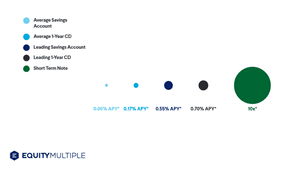I Bond
Series I savings bonds are US government savings bonds. They are non-marketable, meaning they cannot be sold on a secondary market, and interest-bearing, earning a fixed interest rate for the life of the bond and a variable inflation rate that is adjusted semiannually.
For those willing to tie up their capital for at least one year, I bonds are a low-risk way to protect the purchasing power of cash from inflation while also earning interest. I bonds mature at 30 years and may be sold at any point after one year, although cashing out before five years means the investor sacrifices the previous three months’ worth of interest payments.
The fixed interest rate of I bonds is determined by the Secretary of the Treasury every six months, on the first business days of May and November. That fixed rate is then applied to all Series I bonds issued during the next six months is compounded semiannually and does not change throughout the life of the bond (Investopedia).
The inflation rate is similarly determined every May and November based on the Consumer Price Index (CPI). This variable rate is then applied to the bond for six months before being adjusted again. This allows capital held in the bonds to keep pace with inflation and maintain its purchasing power when cashed out.
The fixed and variable rates are used to calculate the composite rate, or the actual rate of an I bond.
Composite rate = [fixed rate + (2 x semiannual inflation rate) + (fixed rate x semiannual inflation rate)]
In instances where inflation is negative, the composite rate is adjusted to 0, which means owners of Series I bonds do not lose money, but instead gain no interest during that period.
Risk vs Return
I bonds are low risk, as they are backed by the US government and their value cannot decline, but are also relatively low yield, with returns comparable to a certificate of deposit (CD) or high-yield savings account.
Taxing I Bonds
Interest earned on Series I bonds is taxable only at the federal level, not state or local levels, and investors may choose from two options for taxation, either the cash method or accrual method. Using the cash method, investors are taxed only upon the sale of the bond. With the accrual method, even though interest is not distributed during the life of the bond, taxes are collected every year on the interest earned during that tax year.
There is one caveat to the taxation of interest, which is when the proceeds are used to pay for qualified higher education expenses in the same calendar year.
The Bottom Line
I bonds can be purchased online from the US Treasury at TreasuryDirect.gov or on paper when filing a federal income tax return. Investors can purchase up to $10,000 in I bonds online or $15,000 on paper. For those interested in another way to earn interest with low risk, EquityMultiple’s Short Term Notes offer a solution. Our notes feature short term holds and attractive interest rates, and serve as an opportunity for diversification. Working on a shorter timeframe than bonds and without fees, Short Term Notes are a low risk, high return alternative.
*Past performance does not guarantee future results
*APYs are based on Bankrate’s National Average survey data, as of August 2021
